|
|
|
 |

 |
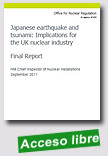 |
Japanese Earthquake and Tsunami: Implications for the UK Nuclear Industry - Final Report
Office for Nuclear Regulation (UK), September 2011, 315 p.
On the 14 March 2011 the Secretary of State (SoS) for Energy and Climate Change requested HM Chief Inspector of Nuclear Installations to examine the circumstances of the Fukushima accident to see what lessons could be learnt to enhance the safety of the UK nuclear industry. The aim of this report is to identify any implications for the UK nuclear industry, and in doing so co-operate and co-ordinate with international colleagues. The SoS requested that an Interim Report be produced by the middle
|
of May 2011, with a Final Report six months later. The Interim Report was published in May 2011.
This is the Final Report, referred to above. This report considers the implications for the UK nuclear industry, and has been expanded from focussing mainly on the nuclear power sector to cover all UK nuclear facilities.
This report provides some background on radioactive hazards, and how people are protected against them. It also provides background on nuclear power technology, and the approach to nuclear safety in the UK, internationally and in Japan. It also describes how we have taken forward the work and how we expect to report on final responses to our recommendations. The report details who we have liaised with and describes the measures we have put in place to provide independent technical advice for our work.
The detailed circumstances of the accident in Japan are not yet fully known and some may not be possible to determine given the loss of control and of certain instrumentation. Nevertheless, we consider that there is sufficient information to further develop lessons for the UK, and it is important to seek to draw early lessons wherever we can and to ensure those lessons are put into action in the UK as soon as possible. Sufficient was known by the time our Interim Report was finalised to enable us to draw key conclusions and recommendations.
Additional information has become available since our Interim Report; in particular, the report of the International Atomic Energy Agency (IAEA) fact‐finding mission to Japan, and a large body of information in a report by the Japanese government. We have reviewed all of this information, and that of the many submissions to us, as well as conducting our own further analysis. This has enabled us to review our Interim Report recommendations and conclusions and undertake a review of the UK regulatory regime and our standards. As a result we have clarified and supplemented our Interim Report recommendations and made some new recommendations and conclusions. We have also set out our approach for taking the work forward.
In taking the findings in this report forward, we should recognise that to achieve sustained high standards of nuclear safety we all need to adhere to the principle of “continuous improvement”. This principle is embedded in UK law, where there is a continuing requirement for nuclear designers and operators to reduce risks “so far as is reasonably practicable” (SFAIRP), which for assessment purposes is termed “as low as reasonably practicable” (ALARP). This is underpinned by the requirement for detailed periodic reviews of safety to seek further improvements. This means that, no matter how high the standards of nuclear design and subsequent operation are, the quest for improvement should never stop. Seeking to learn from events, new knowledge and experience, both nationally and internationally, must be a fundamental feature of the safety culture of the UK nuclear industry.
Extraído de:
http://www.hse.gov.uk/nuclear/fukushima/final-report.pdf |
 |
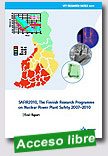 |
SAFIR2010, The Finnish Research Programme on Nuclear Power Plant Safety 2007–2010 - Final Report
VTT Technical Research Centre of Finland, 2011, 582 p.
Major part of Finnish public research on nuclear power plant safety during the years 2007–2010 has been carried out in the SAFIR2010 programme. The steering group of SAFIR2010 consisted of representatives from Radiation and Nuclear Safety Authority (STUK), Ministry of Employment and the Economy (MEE), Technical Research Centre of Finland (VTT), Teollisuuden Voima Oyj (TVO), Fortum Power and Heat Oyj, Fortum Nuclear Services Oy (Fortum), Finnish Funding Agency
|
for Technology and Innovation (Tekes), Aalto University School of Science and Technology (Aalto, former Helsinki University of Technology) and Lappeenranta University of Technology (LUT). In addition to representatives of these organisations, the Steering Group had permanent experts from the Swedish Radiation Safety Authority (SSM) and Fennovoima Oy (Fennovoima). SAFIR2010 research programme was divided in eight research areas that were Organisation and human, Automation and control room, Fuel and reactor physics,
Thermal hydraulics, Severe accidents, Structural safety of reactor circuit, Construction safety, and Probabilistic Safety Analysis (PSA).
Research projects of the programme were chosen on the basis of annual call for proposals. The annual volume of the SAFIR2010-programme in 2007–2010 has been 6,5–7,1 M€ and approximately 50 person years. Main funding organisations in 2007–2010 have been the State Waste Management Fund VYR with 2,7–3,0 M€ and VTT with 2,4–2,7 M€ annually. In 2010 research was carried out in 33 projects.
The research in the programme has been carried out primarily by VTT Technical Research Centre of Finland. Other research units responsible for the projects solely or in co-operation with other institutions include Lappeenranta University of Technology, Aalto University (previously Helsinki University of Technology), Tampere University of Technology, Fortum Power and Heat Oy (previously Fortum Nuclear Services Oy), Finnish Institute of Occupational
Health and Finnish Meteorological Institute. In addition, there have been a few minor subcontractors in some projects.
Extraído de:
http://www.vtt.fi/inf/pdf/tiedotteet/2011/T2571.pdf |
 |
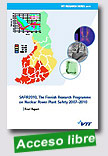 |
The Supply of Medical Radioisotopes: An Assessment of Long-term Global Demand for Technetium-99m
Nuclear Energy Agency (NEA), 2011, 63 p.
This report provides the findings and analysis of the data obtained from a global on-line survey, which sought to understand future demand for 99mTc and diagnostic imaging out to 2020 and 2030. The analysis of the data enabled by the expert advisory group, Technopolis and the NEA to develop the future demand scenario provided in this report. |
Extraído de:
http://www.oecd-nea.org/med-radio/reports/long-term-assessment-99mtc.pdf
|
 |
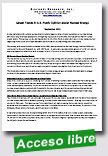 |
A new national public opinion survey that included a large number of trend questions on nuclear energy affords a comprehensive assessment of lingering impacts six months after the Fukushima Daiichi nuclear power event.
The survey, conducted September 22-24, 2011, finds modest declines on most measures, but large majorities continue to |
have favorable opinions about nuclear energy and new plants. The survey, with some questions tracked since 1983, was sponsored by Nuclear Energy Institute and conducted by Bisconti Research Inc. with GfK Roper. A nationally representative sample of 1,000 U.S. adults was interviewed by telephone, with a margin of error of plus or minus three percentage points.
Extraído de:
http://www.nei.org/resourcesandstats/documentlibrary/
reliableandaffordableenergy/reports/latest-trends-in-us-public-
opinion-about-nuclear-energy-sept-2011 |
 |
 |
Mitigation of Hydrogen Hazards in Severe Accidents in Nuclear Power Plants
IAEA TECDOC, 2011, 174 p.
The generation of hydrogen and the risk of hydrogen combustion, as well as other phenomena leading to containment over pressurization in case of severe accidents, represent complex safety issues related to accident management. This publication concentrates on practical aspects of hydrogen risk related computational analysis and implementation of the risk mitigation measures for various reactor designs, with reference to documents already in existence. |
Extraído de:
http://www-pub.iaea.org/MTCD/Publications/PDF/TE_1661_Web.pdf |
 |
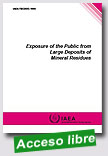 |
Exposure of the Public from Large Deposits of Mineral Residues
IAEA TECDOC, 2011, 62 p.
This publication presents the results of an investigation to determine the doses received by members of the public near large deposits of mineral residues containing radionuclides of natural origin. The key elements of the study were to consider the available information from examples of actual mineral residue deposits, including the results of any relevant dose assessments, and to use this information to define the input
|
parameters for calculating the radiological impact of a representative mineral residue deposit containing 2 million cubic metres of material. The results were found to be consistent with those obtained for actual mineral residue deposits in various parts of the world and confirmed that, for a radionuclide activity concentration of 1 Bq/g in the residue, the annual dose to the most exposed individual would not exceed a small fraction of 1 mSv (millisievert).
Extraído de:
http://www-pub.iaea.org/books/IAEABooks/8647/Exposure-of-the-Public-from-Large-Deposits-of-Mineral-Residues
|
 |
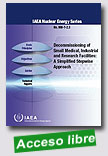
|
Decommissioning of Small Medical, Industrial and Research Facilities: A Simplified Stepwise Approach
IAEA Nuclear Energy Series, 2011, 84 p.
Zero-power reactors, radio-diagnostic and radiotherapy hospital departments or laboratories, as well as factories using radioactive material are often associated with the erroneous perception that their decommissioning is a trivial, low priority activity. This publication provides practical information, experience and assistance aimed at a broad spectrum of practitioners who are faced with decommissioning of such small nuclear facilities. Particular consideration is given to the
|
financial and scientific resources, making efficient and effective decommissioning planning essential. It is written as a simplified, stepwise approach for guidance to nuclear operators and decommissioning implementers with little or no experience in decommissioning. An accompanying CD contains practical information in two Annexes, and is set out in the format of problems encountered, solution and analysis, and lessons learned.
Extraído de:
http://www-pub.iaea.org/books/IAEABooks/8588/Decommissioning-of-Small-Medical-Industrial-and-Research-Facilities-A-Simplified-Stepwise-Approach |
 |
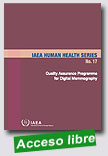 |
Quality Assurance Programme for Digital Mammography
IAEA Human Health Series, 2011, 177 p.
This manual provides a harmonized approach to quality assurance (QA) in the emerging area of digital mammography. It outlines the principles of, and specific instructions that can be used for, a QA programme for the optimal detection of early stage breast cancer within a digital environment. Intended for use by Member States that are now using digital mammography or that are assessing the implications of using digital mammography, it addresses major areas such as: considerations concerning the transition from screen film to digital mammography, basic principles of QA, clinical image quality, quality control tests for radiographers, and quality control tests for medical physicists, including dosimetry assessment. Instructional materials to supplement the knowledge of professionals already working in the field of diagnostic radiology, as well as quality control worksheets, are also provided. |
Extraído de:
http://www-pub.iaea.org/books/IAEABooks/8560/Quality-Assurance-Programme-for-Digital-Mammography
|
| |
| |
|
|
| |
|
|
|
|
|
|
|
|
|
|
